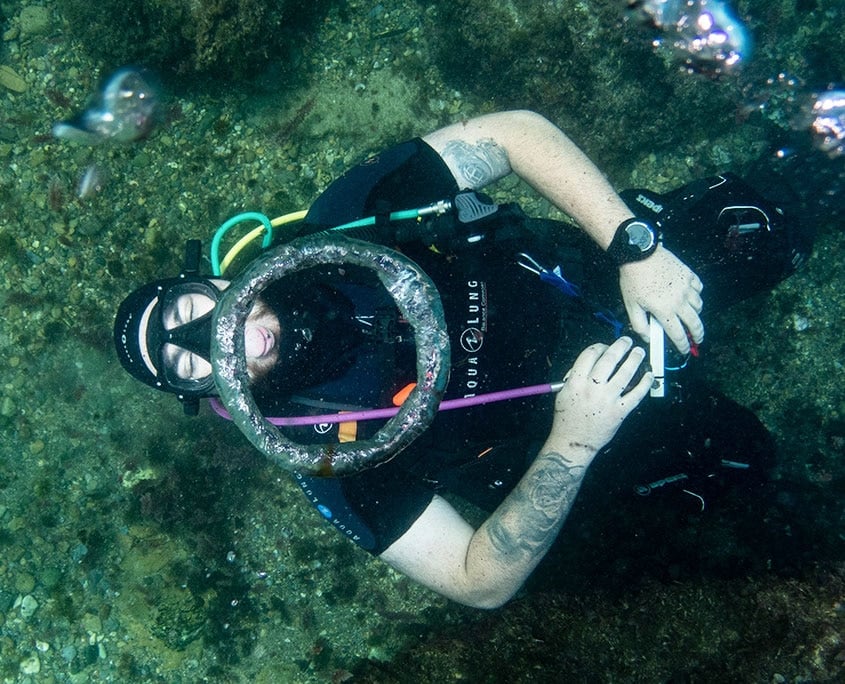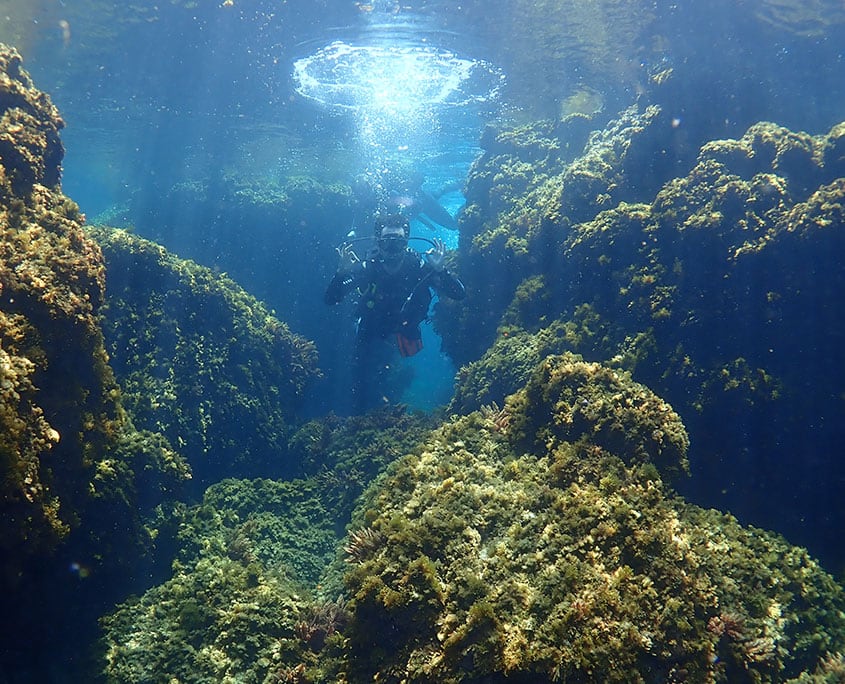The marine reserve at Tabarca island of is one of the most desired places for thousands of divers from all over the world.
It is considered one of the best diving sites in the Mediterranean Sea.

La Galera
Escull Negre
Escull Roig
Arrecifes Artificiales
Cabo de Santa Pola
Tabarca Reef
La Nao
La Llosa (Merolandia)
Pecio 19
Pecio 30
Tabarca Island, established in 1986, was the first marine reserve in Spain, and it remains a stunning example of effective marine conservation. Since then it has been preserved and overfishing has been controlled. Therefore, it is one of the few places in the Mediterranean where we can see extremely large fish in shallow water.
The island’s impressive fields of Posidonia sea grass and rock create a habitat that shelters an abundance of fish seeking protection. As well as having turquoise water, more typical of a Caribbean coast.
Tabarca Island is a tourist attraction that welcomes more than 8000 people a day in the summer months. But luckily for diving, we have a limit of a maximum 10 divers in some spots and in others, 7 divers. This ensures that visitors can enjoy the island’s natural beauty while minimizing the impact of human presence.
PRICE: 80€ for two dives per person + 20€ (equipment rental)
Make your reservation by leaving 40€ deposit:
40,00 €
The best Mediterranean island
Where is it?
Tabarca Island is a small but stunning gem located just 8 km (or 3 nautical miles) off the coast of Santa Pola in Alicante. For those eager to explore its underwater world, it’s conveniently situated close to our dive center, and a quick 20-minute boat ride will transport you to this idyllic location.
What can we see there?
The marine reserve surrounding Tabarca Island has an immense biodiversity and fascinating sea creatures. Giant groupers, schools of thousands of barracudas, graceful stingrays, butterfly rays, lobsters and moray eels are just a few of the remarkable sights you can expect to encounter. Also, the many types of colorful soft coral make it feel like paradise underwater.
Requirements to dive at Tabarca Island.
In order to dive at Tabarca Island you must bring: ID or passport, diving certification, diving insurance (if you do not have diving insurance, we can arrange it for you)

What diving spots will we find there?
We have a wide range of diving spots at Tabarca Island’s Marine Reserve, suitable for all levels. The lack of strong currents makes these dives accessible to everyone, resulting in an enjoyable and safe diving experience.
Tabarca Island Marine Reserve is divided into two areas: the Interior Reserve and the Exterior Reserve. The Interior Reserve features five distinct diving spots, including Escull Negre, Escull Roig, Arrecifes Artificiales, Galera, and Tabarca Reef. The Exterior Reserve, which is further out from the coast, includes two diving spots: La Nao (The Arches) and La Llosa (Grouperland).
To access these spots, a permit is required, which many dive centers in Alicante do not possess. However, we are fortunate enough to be one of the few dive centers permitted to explore the wonders of Tabarca Island’s underwater world.
Beyond the Marine Reserve, we also go to other dive sites: Wreck 19, Wreck 30, stingray point and Santa Pola Cape.
Escull Negre
Difficulty – easy (suitable for all divers from Open Water)
This is one of the best dive sites at Tabarca Island, located in the Interior Reserve. It is called “Escull Negre” which means black rock in Valenciano, the language of the Valencian Community. It submerges from the water on the south face of the island.
At a depth of just 15 meters, it is considered one of the most biodiverse spots on the island. You can witness an incredible abundance of marine life here, including schools of thousands of barracudas, groupers, rays, meagres, salema fish, octopus, congers, nudibranchs, zebra sea breams, and much more.
This shallow dive spot is perfect for those who want to dive without worrying about air consumption, as most of the time, we will be at 7-8 meters depth.
Escull Roig
Difficulty – easy (suitable for all divers from Open Water)
Located close to Escull Negre on the south side of the island, we can find a lovely dive site called Escull Roig, which means Red Rock. During the dive, we will explore the red rock as well as the nearby sandy areas in search of stingrays
This dive site is the best spot to find the rare Mediterranean slipper lobster, which is considered a rare species due to overfishing. However, we are fortunate enough to see them often, so let’s keep it a secret. We can also find see nudibranchs, scorpion fish, starfish, large Posidonia meadows, moray eels, and much more!
It is an easy dive, the maximum depth is 14 meters and we will be at 5- or 7-meters depth most of the time, so you will not have to worry about your air consumption.
Arrecifes Artificiales (Artificial Reef)
Difficulty – medium (suitable for all divers from Advanced Open Water)
At the “Artificial Reef” dive spot there are 4 pyramid-shaped structures made of concrete blocks which were purposely sunken years ago to prevent trawling fishing boats from destroying the beautiful seabed that surrounds Tabarca Island.
The concrete blocks at “Artificial Reef” are hollow, cube-shaped structures that lay on a sand bed at 24 meters depth. Over time, an artificial reef has formed, creating a refuge and protection area for uncountable marine species. Offering us at the same time a fantastic diving spot.
Divers at the “Artificial Reef” can observe scorpion fish, giant groupers weighing over 40kg, schools of thousands of salema fish, white bream, and much more. We can also visit the remains of a sunken fishing boat near the artificial reef occupied by moray eels, congers and many more species.

La Galera
Difficulty – easy (suitable for all divers from Open Water)
La Galera is a small Island next to Tabarca, which has a remarkably interesting feature, its orography. In addition to an incredibly significant topography, where we can find some rock corridors and a cave.
It is a shallow dive and the visibility is usually excellent there.
We can see all kinds of fish, but this specific point is quite unpredictable since sometimes we see marine life that is not seen anywhere else in Tabarca’s marine reserve.
La Nao
Difficulty – easy (suitable for all divers from Open Water)
Without a doubt, La Nao is one of the best diving sites in the Mediterranean Sea. Hundreds of photographers come here each year to capture amazing photos of its marine flora and fauna. The light entrances through tunnels and arches full of fish is what makes it so incredible for taking photos. Also, it is a shallow dive, so the light reaches everywhere.
During this dive we will follow a strip of rocks until we reach some arches, here we can find a wide variety of marine life. Like hundreds of varied fish and the maximum depth is 10 meters.
We can see giant groupers, sea cicada, sea breams, salema fish, cuttlefish, octopus and in the sandy area we sometimes find stingrays.
This dive will not disappoint any diver and it has a special charm because the fish there do not see you as a threat and they get very close to divers making us feel part of the ecosystem.

Tabarca Reef
Difficulty – easy (suitable for all divers from Open Water)
It is called Tabarca Reef or Cemetery. Do not worry, it’s not called cemetery due to a lack of fish. Moreover, we can find abundance of fish, including large schools of barracudas and some Spanish dancer nudibranch.
This dive spot is located on the north face of Tabarca Island, in line with the cemetery. It is a fairly easy dive and the maximum depth will be 15 metres.It is characterised by its interesting topography, made up of a row of rocks, one on top of the other, creating passageways to explore. Surrounding the depths, we can find meadows of Posidonia sea grass, a great area for many fish to hide and protect their selves.
We will see Mediterranean reef like gorgonian, sea sponges and ascidians. We often see rays, barracudas, some groupers and much more
Pecio 19
Difficulty – easy (suitable for all divers from Open Water)
This dive spot is located just outside Tabarca Island’s Marine Reserve. We normally throw the anchor to around 12 meters depth and we descend through an interesting canyon type rock while observing a huge cloud of bogues swimming in sync. Then we will see, on the seabed, a sunken wooden fishing boat. If you take a close look in the propeller shaft there is normally a conger eel hidden there. This dive spot can be very surprising.
Here we can find small groupers, sting rays, barracudas, spanish dancers, conger eels, moray eels, sting rays and much more! The maximum depth is 19 meters.

Pecio 30
Difficulty – medium/high (suitable for all divers from Advanced Open Water)
At this dive spot we can find the remains of 3 sunken wooden boats on the seabed at 30 meters. From all the diving spots at Tabarca Island, this is the one where we are most likely to see sunfish, sometimes we have seen more than 20 together. They like this area because there are a lot of rainbow wrasse or “coris julis” and they clean the Sunfish. Let’s say it’s like a spa day when they come here. We can also see moray eels, a big conger eel and a variety of many other fish.
There can be strong current here sometimes so we can also find quite big fish.
La Llosa (Grouper-land)
Difficulty – medium (suitable for all divers from Advanced Open Water)
This is a dive you cannot miss is you visit Alicante!
It is considered one of the best diving spots in Spain and of the entire Mediterranean Sea.
The depth in La Llosa is between 19 and 28 meters, and the dive can be done in 2 different ways depending on level of the divers.
The shallowest part of the dive is at 24 meters, what we do is circle a rock or “llosa” and enjoy the view, dozens of gigantic groupers (hence the name grouper-land), mottled groupers, goldblotch groupers, thousands of barracudas, stingrays, massive moray eels, octopus, anemones, etc. Then we will ascend gradually until we reach 19 meters, at this point if you look from side to side you will be surprised by thousands of fish surrounding us. The most amazing thing about this dive spot is you can get extremely close to the groupers, without touching them. Just think about the amazing pictures you will be able to take.
At the deepest part of the dive,28 meters, we will view some tunnels and rocks. Here, we are sometimes surprised by different types of less common fish like sunfish and eagle rays.
Dive Academy Santa Pola
Address:
Marina Miramar, Puerto Deportivo 2, Local 3
03130 – Santa Pola (Alicante) España
MULTIAVENTURA SANTA POLA, S.L. B42703918
Contact us
Telephone: +34 966 699 088
Mobile: +34 648 463 310
e-mail: info@diveacademy-santapola.com



